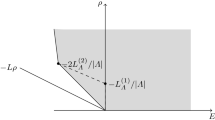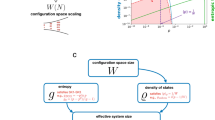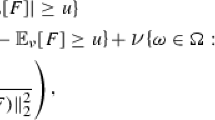Abstract
Jaynes’s entropy concentration theorem states that, for most words ω1 ...ωN of length N such that \(\mathop \Sigma \limits_{i = 1}^{\rm N} \;f(\omega _i ) \approx vN\), empirical frequencies of values of a function f are close to the probabilities that maximize the Shannon entropy given a value v of the mathematical expectation of f. Using the notion of algorithmic entropy, we define the notions of entropy for the Bose and Fermi statistical models of unordered data. New variants of Jaynes’s concentration theorem for these models are proved. We also present some concentration properties for free energy in the case of a nonisolated isothermal system. Exact relations for the algorithmic entropy and free energy at extreme points are obtained. These relations are used to obtain tight bounds on uctuations of energy levels at equilibrium points.
Similar content being viewed by others
REFERENCES
Jaynes, E.T., Papers on Probability, Statistics, and Statistical Physics, Dordrecht: Kluwer, 1989.
Cover, T.M. and Thomas, J.A., Elements of Information Theory, New York: Wiley, 1991.
Li, M. and Vitanyi, P., An Introduction to Kolmogorov Complexity and Its Applications, NewYork: Springer, 1997, 2nd ed.
Stratonovich, R.L., Teoriya informatsii (Information Theory), Moscow: Sov. Radio, 1975.
Landau, L.D. and Lifshitz, E.M., Statisticheskaya fizika, Part 1, Moscow: Nauka, 1976. Translated under the title Statistical Physics, vol. 1, Oxford, New York: Pergamon, 1980.
Jaynes, E.T., How Should We Use Entropy in Economics? (Some Half-Baked Ideas in Need of Criticism), unpublished manuscript. Available from http://bayes.wustl.edu/et/etj/articles/entropy.in. economics.pdf.
Maslov, V.P., Integral Equations and Phase Transitions in Probability Games. Analogy with Statistical Physics, Teor. Veroyatn. Primen., 2003, vol. 48, no.2, pp. 403–410 [Theory Probab. Appl. (Engl. Transl.), 2003, vol. 48, no. 2, pp. 359-367].
Kolmogorov, A.N., Three Approaches to the Quantitative Definition of Information, Probl. Peredachi Inf., 1965, vol. 1, no.1, pp. 3–11 [Probl. Inf. Trans. (Engl. Transl.), 1965, vol. 1, no. 1, pp. 1–7].
Kolmogorov, A.N., The Logical Basis for Information Theory and Probability Theory, IEEE Trans. Inform. Theory, 1968, vol. 14, no.3, pp. 662–664.
Zurek, W.H., Algorithmic Randomness and Physical Entropy, Phys. Rev. A, 1989, vol. 40, no.8, pp. 4731–4751.
Rissanen, J., Minimum Description Length Principle, Encyclopaedia of Statistical Sciences, vol. 5, Kotz, S. and Johnson, N.L., Eds., New York: Wiley, 1986, pp. 523–527.
Gacs, P., Tromp, J.,and Vitanyi, P., Algorithmic Statistics, IEEE Trans. Inform. Theory, 2001, vol. 47, no.6, pp. 2443–2463.
V’yugin, V.V. and Maslov, V.P., Extremal Relations between Additive Loss Functions and the Kolmogorov Complexity, Probl. Peredachi Inf., 2003, vol. 39, no.4, pp. 71–87 [Probl. Inf. Trans. (Engl. Transl.), 2003, vol. 39, no. 4, pp. 380–394].
Bogolyubov, N.N., Energy Levels of the Non-Ideal Bose-Einsten Gas, Vestnik Moskov. Univ., 1947, vol. 7, pp. 43–56.
Uspensky, V.A., Semenov, A.L., and Shen’, A.Kh., Can an Individual Sequence of Zeros and Ones Be Random?, Uspekhi Mat. Nauk, 1990, vol. 45, no.1, pp. 105–162 [Russian Math. Surveys (Engl. Transl.), 1990, vol. 45, no. 1, pp. 121–189].
Kolmogorov, A.N. and Uspensky, V.A., Algorithms and Randomness, Teor. Veroyatn. Primen., 1987, vol. 32, no.3, pp. 425–455 [Theory Probab. Appl. (Engl. Transl.), 1987, vol. 32, no. 3, pp. 389–412].
V’yugin, V.V., Algorithmic Complexity and Stochastic Properties of Finite Binary Sequences, Computer J., 1999, vol. 42, no.4, pp. 294–317.
Kolmogorov, A.N., Combinatorial Foundations of Information Theory and the Calculus of Probabilities, Uspekhi Mat. Nauk, 1983, vol. 38, no.4, pp. 27–36 [Russian Math. Surveys (Engl. Transl.), 1983, vol. 38, no. 4, pp. 29–40].
Author information
Authors and Affiliations
Additional information
__________
Translated from Problemy Peredachi Informatsii, No. 2, 2005, pp. 72–88.
Original Russian Text Copyright © 2005 by V’yugin, Maslov.
Supported in part by Grants of the President of the Russian Federation for Leading Scientific Schools, nos. 358.2003.1 and 1678.2003.1, Russian Foundation for Basic Research, project no. 03-01-00475, and the joint Russian-French RFBR-CNRS grant, no. 02-02-22001.
Rights and permissions
About this article
Cite this article
V’yugin, V.V., Maslov, V.P. Concentration Theorems for Entropy and Free Energy. Probl Inf Transm 41, 134–149 (2005). https://doi.org/10.1007/s11122-005-0019-1
Received:
Accepted:
Issue Date:
DOI: https://doi.org/10.1007/s11122-005-0019-1




